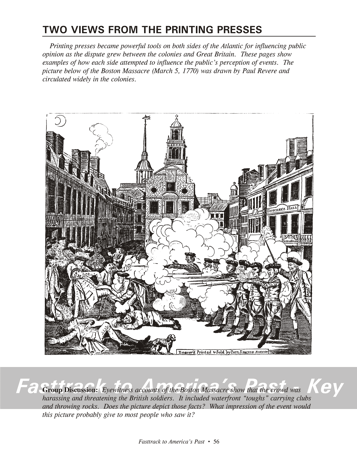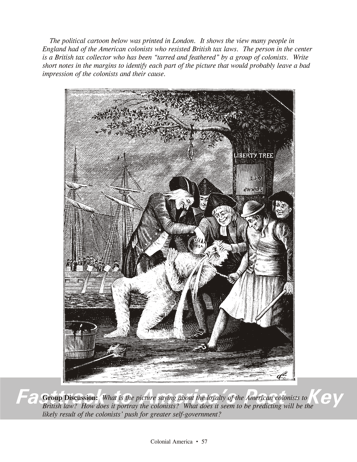| Fasttrack
to America's Past Teacher Key |
|
| Fasttrack
to America's Past Teacher Key |
|
 Page 56  Page 57 |
Pages 56
& 57 - Two Views from the Printing Presses The drawing, page 56 The pictures shown on these pages give students insight into the arguments and emotions that swirled around relations between the colonies and Great Britain in the 1770s. They also show that the printing press was already developing into a tool for shaping public perceptions of events. The first picture shows Paul Revere's version of the Boston Massacre. The overall impression Revere creates is that British soldiers fired point blank into a crowd of peaceful citizens for no reason. The words "Butcher's Hall" are on a building visible in the background, perhaps to suggest the best term for colonists to use to describe the British soldiers.The image is a good example of what would later come to be called propaganda. Revere's image has a political purpose, namely, to inflame opposition to the British presence in Boston. It is not concerned with showing the complete facts, or showing fairness to each side. Later testimony from eyewitnesses made it clear that the colonists were not blameless, and deliberately provoked the soldiers. The soldiers themselves were frightened for their safety as the mob pushed in around their post. Group discussion questions, page 56 While Paul Revere's picture is based on an actual incident, the picture does not give all the facts. The British soldiers appear to be slaughtering the colonists for no reason at all. The colonists themselves are shown as well dressed gentlemen, perhaps out for a stroll, not a mob harassing and provoking the soldiers. The British officer appears to be giving a command to aim and fire. The soldiers are standing in line, calm and deliberate as they shoot the colonists. The implication is that this was murder, not a panic response by frightened soldiers. Any colonist seeing the image would probably interpret it precisely as Revere intended, as an unprovoked and brutal attack on colonists by the British soldiers. The drawing, page 57 This well known image printed in London is also a good example of how the printing press was used to spread a political viewpoint in the 1770s. Like the picture on the facing page, the image is not totally false or made up. Some British tax collectors were tarred and feathered, and the colonists did dump British tea into Boston harbor. But the artist chooses and arranges the elements of the picture in a way that deliberately puts the colonists' actions in the worst possible light. Students should go through the picture piece by piece, and jot short notes in the margins as they go. For example, a Liberty Tree is shown, but on the tree is a British law, the Stamp Act, turned upside down. On a branch hangs a noose. Under it's spreading branches a group of thugish looking colonists has ganged up to assault a lone tax collector. This would be a good time to show examples of modern political cartoons. Students should discover that they do not necessarily depict facts and people fully or fairly. They are designed to make a statement and influence the public's perception of issues and events.Group discussion questions, page 57 The picture makes a clear claim that the
American colonists
were not decent law-abiding citizens, but thugs who openly defied
English
laws and customs. |
|
Copyright Notice
Copyright 2018 by David Burns. All rights reserved. Illustrations and reading selections appearing in this work are taken from sources in the public domain and from private collections used by permission. Sources include: the Dover Pictorial Archive, the Library of Congress, The National Archives, The Hart Publishing Co., Corel Corporation and its licensors, Nova Development Corporation and its licensors, and others. Maps were created or adapted by the author using reference maps from the United States Geological Survey and Cartesia Software. Please see the home page for this title for more information. |